Sunday, 30 September 2012
Voiceover
My interpretation of Voiceover is when a voice can be heard by the audience, and more often than not, is 'not' heard by the characters on screen, this voice often acts as guidance or communicates a narrative to the audience.
I believe a voice over was used in this scene to give a recap of the story by relaying crucial information to the audience in an engaging manner making the audience become more immersed in this world and as a result are more entertained by it.
Mode Of Address/Direct Address

My interpretation of this is essentially the method in which a person(s) are targeted by the speaker(s) i.e loud speaker, acoustic etc. This can be direct i.e. the speaker is shown to be attempting to talk to/ address a person or the audience.
In the above scene I believe this was used to convey critical information to the audience without breaking the overall tone of the show/ the forth wall. As a result the image and sound dialogue is played through a monitor through to the character in the chair. This makes the information and the method in which it is delivered have a more outlandish/ syfi feel to it and as a result makes it more entertaining to watch.
Sound Effects
My interpretation of sound effects is basically the opposite of Synchronous Sound, i.e. it is noise that is added during pre-production/ after it is initially filmed. This is usually to emphasise a noise made by an object or an action e.g.a punch.
I think sound effects have been used in this scene (and throughout the show) to create a more entertaining, atmospheric adventure for the audience, whether it be the clicking and beeping of these futuristic styled computers, the erratic noises used to emphasises various activities occurring around the hub or the frantic and syfi influenced noises heard from the computer itself.
Sound Bridge
My interpretation of Sound Bridge is when a scene begins the sound from the end of the previous scene is carried over before any new sound begins.
I believe that a Sound Bridge was used here, similarly to the beginning to any primeval episode when the sound from the end of the title screen (reminiscent of a creatures screech) is carried forth through the opening few seconds of the next scene. This creates a more entertaining entrance to the start of a scene and as a result makes it more enjoyable for the audience to watch.
Sound Perspective
My interpretation of this is the sense/ feeling of a sounds location (in a space) given by its loudness, volume and pitch.
I think sound perspective was used in this scene to try and convey to the audience an added sense of realism to the viewers as it attempts to communicate the position of various noise sources throughout the café/ restaurant as we he the banging of glasses, the shuffling of tables and the whispers of people. This along with the passing of cars and cabs outside which appear diminished in sound whilst inside the restaurant but when the scene transitions to outside they're appear more clear and louder as they drive past, given a more engaging and appropriate representation of their location in space.
Sound Motif
My interpretation Sound Motif is when a sound/ combination of sound effects is used to connect the audience with a particular character, event, location or action or even to express an emotive response from the audience/ signify how they should react to a scene with these cues. Its basically a noise generated to get a response from the audience.
I believe a Sound Motif was used in the above scene to communicate a change in the mood of the scene, as it changes from almost a warm and light hearted conversation to a more serious, dark and atmospheric tone. This makes the scene appear more entertaining and emphasises certain characterisations about the characters on screen and their methods of observation.
Sound Mixing
My interpretation of Sound mixing is when during the post production stage, sounds and layers of sounds and their attributes are combined and altered for various effects.
I believe Sound mixing was used in the above scene to increase the volume of the various sounds audible throughout the scene that otherwise would not be that easy to hear such as the tapping of Sherlock's fingers on the table or the clattering of wine glasses across the room. This makes the audience more keen to pay attention to the small details and overall what is happening.
Friday, 28 September 2012
Synchronous Sound

My interpretation of Synchronous sound is similar to that of Diegetic Sound, as the noise audible is the noise that was present when the scene was initially filmed.
I believe this was used in the above scene to give it a more human, realistic feel, as there is no music, unnatural background noise, only the swaying of the pool waster and the characters themselves. This results in the addition of tension and an almost darker yet more entertaining atmosphere.
Non Diegetic Sound

My interpretation of Non- Diegetic sound is basically the opposite of Diegetic noise i.e. noise which the audience can hear but the characters on screen cannot. This is often to display cues, scene transactions or for background music.
The use of this in the above scene increases the tension as the piano (riffs) slowly build up which almost prematurely communicates an event/action to the audience, making the resulting scene more engaging and entertaining.
Diegetic Sound
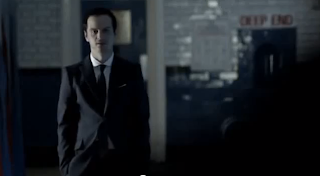
My interpretation of Diegetic Sound is the sound(s) which are audible to the audience are also audible to the characters on screen, in the above scene this being the sound of the movement of the pool water.
This results in a more atmospheric, almost realistic experience for the audience to view, making it in turn more entertaining and enjoyable.
Thursday, 27 September 2012
Asynchronous Sound
My interpretation of Asynchronous sound is when a noise/ sound is heard by the cast off screen, the characters may know what this noise is or where the source is coming from but at this point it has not been revealed to the audience.
I believe Asynchronous sound was used in the above scene to communicate a more tense, eerie and mysterious atmosphere to the audience as they hear what appears to be this quite horror styled, ear piercing, metallic scraping noise which is later revealed to be a swinging ceiling light. This adds to the tension and in turn engages the audience more.
Fade in / Fade Out
My interpretation of Fade in / Fade out is that it is the gradual transaction from a blank screen to a desired image, and then a further gradual transaction from the image to a blank screen.
I believe that this was used in the above scene to add dramatic tension, almost pulsing like a heartbeat, which in turn further emphasises the tense and dark atmosphere displayed by this scene.
Wednesday, 26 September 2012
Dialogue

Dialogue is essentially the lines spoken by an actor, usually used to convey information to the audience either by themselves or through the exchange of dialogue between actors.
Dialogue was used in the above scene to communicate information to the audience as well as convey the tone and atmosphere of the scene and show how distressed Sherlock and Watson are as apposed to the unpredictable eccentric nature of Moriarty through his attitude and spoken words.
Visual Effects
My interpretation of Visual Effects is when imagery is manipulated beyond whats natural, this may be because the scope of creating the effect without the software i.e. creating an excessively large, expensive set. It would in reality cost a lot more time and money to do this rather than use visual effects software.
I believe Visual Effects was used in the above scene to make it more artistic and visually appealing, with an added tech effect. This Gives the impression of first person view though a helmet with an attached camera with the various writing and recording symbol superimposed on. This gives the impression almost as if they're dealing with hazardous materials in a hazmat suit or the like. This makes it more entertaining and appealing for the audience to watch.
Superimposition
I believe that Superimposition is when multiple images are exposed on the same film strip causing concealment of certain areas/ items on the base image. This may also be used for various effects from the added layers of images.
I think this was used in the above scene to communicate a syfi feel and aura to the audience with its blue tint and multiple super imposed layers (Black Space background - Futuristic city - Space ship). This makes it interesting for the audience to watch and is immediately recognisable as having a science fiction theme.
Post Production
My interpretation of Post Production is essentially all the processes involved after the initial shooting of the film. From image editing, audio manipulation and editing and cuts, to visual & digital effects, transactions and manipulation of time. This process often takes longer than the actual shooting of the film.
Post production was used in the above scene to splice together short sequences and important parts from previous episodes with various transaction techniques to give a nostalgic feel while displaying all the necessary information to the audience in an engaging way.
Long Take, Short Take
My interpretation of a long take is essentially a long uninterrupted shot, sometimes lasting for minutes.
while a short take which only lasts for (if even) a few seconds, as apposed to the long take.
I believe the Long Take was used above so that a lot of information can be delivered to the audience without changing cameras, emphasising the importance of the scene and the information being delivered in turn.
I think the Short Take was used simply to display the detail of the scenery and set as it quickly jumps between short panning takes.
Ellipsis & Expansion Of Time
Ellipsis:
Expansion Of Time:
My interpretation of Ellipsis is basically when a cut, effect or transaction is used while editing to signify the passage of time or remove unneeded scenes from a film such as a walk down the street to the shop as apposed to editing the scene removing the traversal of the street and just showing the person arrive at the shop. Expansion Of Time is basically the opposite, essentially a form of slow motion as it shows the slow passage of time as opposed to the swiftness of its passage with Ellipsis.
I think Ellipsis was used in the above scene to remove some unneeded content and skip straight to the important plot point to keep the audience engaged.
I believe Expansion Of Time was used in the above scene similarly to slow motion as it communicates time is ticking away as these people entertaining themselves through bowling, possibly foreshadowing an event in a dynamic fashion.
Thursday, 20 September 2012
Slow Motion
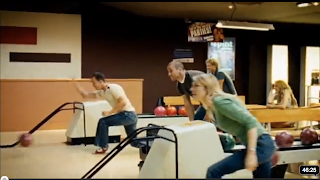
My interpretation of Slow Motion is when a scene or an action is slowed down significantly beyond reality. This is often used so that the audience can see an action in more detail than usually possible.
I believe this technique was used so that the action of the characters bowling is slow down by a significant amount allowing for an almost comical, enjoyable atmosphere surrounding the action, it is easier to see action occurring and the characters movements. This means the audience have more of an opportunity to perceive what is happening and as a result pay more attention.
Sunday, 16 September 2012
Action Match
My interpretation of Action Match is when an action is being captured, then the perspective is suddenly changed i.e the camera is moved to a different location or angle, but the same action is still being shown, albeit from a different perspective.
I believe this was used in the above scene to allow almost a fluency or seamless flow between the short scenes in which appears to be very visually appealing to the audience.
Wipe
My interpretation of the Wipe transaction is when an image transaction occurs between two scenes, the first scene is moved/swiped off screen to show the next scene. The are various ways this can be done : vertically, horizontally a shape in the centre gradually getting bigger etc.
This results in a scene transaction change as the flared shape in the centre gradually enlarges giving it an overall more aesthetically pleasing and interactive experience.
Shot/Reverse Shot
My interpretation of the Shot/Reverse Shot is similar to an Eyeline Match as the initial scene shows one character looking at another character, then a cut is included showing the second character looking back at the first character, the premise is that these characters are talking or engaging with one another.
This results in almost a back and forth between the characters as the camera in turn shows what the previous character was looking at i.e matching their eye level/ what they see. This makes the scene appear more important and dramatic in turn.
Cut
A cut is essentially a transaction of either image or sound. Combined with many other techniques such as crossfade etc. it can be used to show a change in location, atmosphere or even just to continue on with a scene.
The above results in simply showing the movement of car from location to location as it gradually comes closer to the house without the camera constantly following it. This results in a quicker scene, not wasted on the boring journey along the road and a more slick splicing of scenes which in turn keeps the audiences attention.
Crossdissolve & Crossfade

My interpretation of both these transactions is similar to both dissolve and fade except this time it refers to the blending and eventual transaction of two or more audio files in a scene using various software. This may be to used to manipulate the mood or atmosphere of a scene.
The result is through the seamless and smooth transaction of audio files one scene appears to blend with the next without the audience even realising, to as insure not to lose the audiences attention.
Cutaway
My interpretation of a Cutaway shot is when a scene is interrupted by a cut showing a completely different scene occurring, often used with a lethargic atmosphere as it may show someone reminiscing or remembering the past, or this may be used often for humorous effect.
The result is unlike a normal cutaway, the scene showing a seemingly alien planet is scanned over before cutting away to the character reminiscing of this location. This gives a lethargic atmosphere to the scene and adds an element of mystery as the audience wants to know more.
Eyeline Match
My interpretation of Eyeline match is when the initial scene shows the subject looking off screen then a cut is included to show what the subject is looking at off-screen. This is used to further immerse the audience into the scene making them feel part of it in-turn.
This results in the audience being able to see off camera what the character is able to see. Making the audience seem part of the scene and as a result is more engaging.
Insert
My interpretation of an Insert cut is similar to that of a cutaway as it interrupts the proceedings of the master shot but unlike a cutaway, the insert instead shows the master shot from a different angle and/or distance as well as perspective.
The result is that as the master shot is interrupted by this insert, we get a different perspective to view the original master shot, this further immerses the audience, almost making them feel part of the action/scene.
Parallel Editing & Crosscutting
My interpretation of Parallel Editing is when a cut is made during one scene to show another scene happening simultaneously often at a different location, this is often used in action sequences. This goes the same for cross cutting except with parallel editing it can be more than two simultaneous sequences occurring.
The result is two scenes going on at the same time, whilst flicking between the two, this creates a tenser faster paced atmosphere for the viewers to experience.
Dissolve & Fade
My interpretation of the Dissolve transaction is basically a gradual transaction between two scenes or images to almost make them blend together for a moment to give a smooth scene swap/cut. Dissolve is the gradual transaction from one image to another as opposed to just simply a transaction to a blank screen. Fade, similarly is a darkening/ gradual blur transaction between scenes in which a transaction occurs but to a blank screen as apposed to another image.
the result is a gradual but effective transaction that actually makes the scene swap quite entertaining for the audience as it slowly blurs/dissolves.
Digital Effects
My interpretation of digital effects is when a computer generated image (CG I) or various other manipulating effects are used in a scene, these effects are not actually present when initially filming but added/edited in at a later stage in development. This is also the use of the various effects used in image and sound transactioning, (cross)fading, (cross)dissolving and so on.
The result is the production of a mythological created creature as opposed to a real animal. This gives the screen an inhuman, enhanced experience to view the scene with something people would never normally see adding to the immersive experience.
Jump Cut
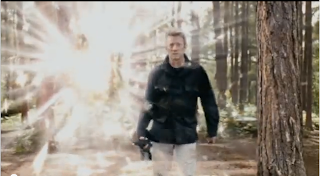
My interpretation of jump cut is when there is a sudden, unexpected jump between scenes over long distances or varying lengths time i.e this is often used in trailers, or a re-caps of the storyline.
I think this cut was used in this scene to give a sense of fast paced-ness and urgency, as it tries to cover as much ground and detail in so little time, this makes the scene appear much more interesting and out-of-world as the timeline changes back in time. This results in an (almost) believable universe which often appeals to many viewers as it quickly and abrubptly changes location, removing the need for useless details.
Graphic Match
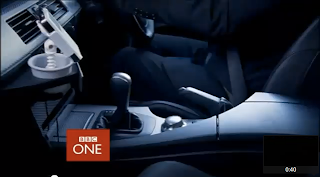
My interpretation of Graphic Match is when an object almost morphs into another object resembling it (usually in a metaphorical sense) such as a traffic light blending/morphing into the sun. The above scene is more literal as the gear stick of the relatively new car morphs into that of a car from the past, signifying a change in time.
As already stated I believe this was used in this scene to signify a change in time, almost in a comical fashion. This results in a more entertaining method to deliver crucial information shrouded in mystery, as the audience remain interested and want to learn more.
Friday, 14 September 2012
The Importance Of Editing
Editing is one of if not the most crucial part in filming. The transitioning between scenes whether it be with images, sounds or effects it makes the overall film/ individual scene far more entertaining and visually/ aurally enjoyable. Editing can transform a seemingly average acted scene and transform in into a more aesthetically pleasing scenario. The use of CGI has been met with almost a certain stigma surrounding it, as its overuse has almost made redundant the need for actual actors and skilled acting. Nevertheless it along with the mass of various mixing, splicing, angles, compositions methods etc. editing remains a pivotal part of designing a making a film. The combining of images and sounds to make a much more smooth streamline transaction between scenes and the correct use of various composition techniques and camera angles contributes greatly to how well the components of the scene fit together and how well in turn this will be received by the audience.
Transition Of Image & Sound
The Transition Of Images is essentially the combination of various shots and scenes for many effects such as the passage of time, movement from location to location, to express a desired tone, mood or atmosphere. It can also be used to simply continue on with the story or for the likes of cutaways and side stories. Regardless of the desired reasoning for the splicing of these scenes and shots together it makes a scene far more entertaining and appealing for the audience to watch and follow with relative ease.
The Transition Of Sound is more or less similar to that of images in that it is essentially the splicing of various noises, sounds, music and soundtracks to create various effects. This is often brought upon by a change is scene location, mood, to indicate a critical event has occurred, for humorous or dramatic effect. This combination of noises as such which in turn is combined with the splicing of images etc. it makes for an extremely entertaining and engaging scene.
The Transition Of Sound is more or less similar to that of images in that it is essentially the splicing of various noises, sounds, music and soundtracks to create various effects. This is often brought upon by a change is scene location, mood, to indicate a critical event has occurred, for humorous or dramatic effect. This combination of noises as such which in turn is combined with the splicing of images etc. it makes for an extremely entertaining and engaging scene.
Thursday, 13 September 2012
Rule Of Thirds
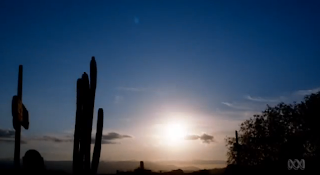
My interpretation of Rule Of Thirds is when an image is initially divided up into a grid of nine squares (two equally spaced horizontal and vertical lines) and along these lines lie the main focal point of the scene, in the above images case: the cactus vegetation and the horizon all lie on this grid.
I think this style was used in this scene to make this image more aesthetically appealing, clean cut and overall more even and balanced. This styles overall makes the image more presentable and allows for the audiences attention to be drawn to any objects of interest which would respectively set the scene i.e. the cactus implys a western styled setting. This results in a more engaging better looking image that grabs the viewers attention by highlighting various objects and details throughout the image.
Focus Pulls
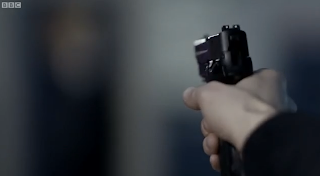
My interpretation of Focus Pulls is essentially the same as Depth Of Field, but instead of only one area of the scene remaining obscured and blurred a switch occurs in which both areas swap obscurity i.e. the area that was once clear becomes blurry and vice versa.
I believe this was used in this scene once again to only display what is important/necessary in the scene, the switch over initially from Moriarty to Sherlock wielding a handgun also emphasises his motivation and mindset in which he may or may not pull the trigger. This results in a more entertaining and tense scene as the audience initially remain unsure of Sherlock's decision in this stressed scene,
Depth Of Field
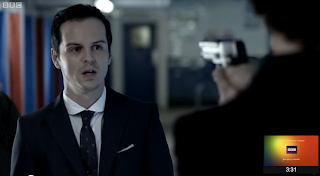
My interpretation of Depth of field is when a certain area of the shot, usually either the foreground or the background is unfocused and blurry, leaving the other area to remain clear and detailed. This allows the audience to not be distracted by occurances or the set design, it can also be used to deliver a horror styled scene.
I think this technique was used in this scene to keep the focus on the main focal point of the scene, Sherlock and Moriarty. The background is blurred and so they wont be distracted and remained focused and observant towards the actions a detail of both the subjects. This results in a more engaging atmospheric scene in which the viewers remain focused on only whats important in this scene.
Framing

My interpretation of a framing shot is when a subject(s) is framed/centred around essentially a boarder usually of a window (styled) image or in this case through hedges.
I think this was used in tis scene to coin-side with both the hand held and first person feel of the scene, this results in a more dark and sinister atmosphere as the person watches the characters through the frame of branches and leaves. This results in a more dramatic and atmospheric scene for the audience to view and results in a more entertaining experience.
Wednesday, 12 September 2012
Handheld
My interpretation of Handheld is when a scene is shot with a single camera held in someones hand. This may be used to give more of a first person perspective on certain events and may be used for such as the likes of documentaries.
I think this technique was used in this scene to simulate a first person viewpoint, it gives off a feeling that the characters in this scene are being watched and possibly stalked by an off screen persona. This results in a more tense, horrifying experience as a terrible event is possible being foreshadowed by this eerie use of the camera, causing a more engaging atmospheric experience for the audience.
Reverse Zoom

My interpretation of Reverse Zoom is essentially the opposite of the Zoom technique, as it reduces the images size as the camera pulls further away. This as a result reduces detail on immediate objects but also shows a lot more of the set and scenery than what was previously visible.
I believe this was used in this scene to initially display the focal point/event of the scene i.e. the car crash. As it zooms out more of the surrounding area becomes visible allowing the audience to see the damage and carnage that has occurred. This results in a more dramatic experience of the scene as the audience becomes aware not only of the consequences for those involved directly in the crash but also the damage caused to the surrounding locations from a birds eye view.
Crane
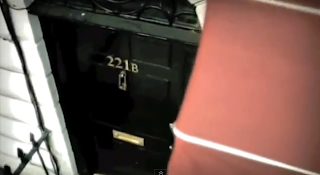
My interpretation of Crane is when a scene is shot from a elevated position (that would otherwise you would be unable to reach) that can be easily altered during filming i.e. moved up and down using the crane equipment. This may be to show detail of the setting/scene that would otherwise be unable to reach by getting a higher vantage point.
I think this was used in this scene to initially give the viewers a high perspective allowing viewing of the buildings detail and such, as it slowly lowers it becomes evident that the door of this building is the focal point of the scene. This results in the audience paying more attention to the surroundings and sets the location for following scenes.
Steadicam

My interpretation of Steadicam is similar to a dolly as it is able to steadily and smoothly circle around a subject without the shaking of a camera, except unlike a dolly shot it is not shot on rails. This may be to give an easier seamless traversal over rough terrain.
I believe this technique was used in this scene for quick and smooth traversal over the foliage of the forest. This results in a swift and smooth circular transaction around the cast without any shaking of the camera. This possible makes it more aesthetically pleasing for the audience to watch and allows for them to view more of the environment as well as the cast.
Zoom
My interpretation of the zoom technique is when the image gradually gets bigger and detailed as the camera closes in (enlarges an image in the distance). This could be to put emphasis on a subject usually a person or an object, or to communicate intense drama or an important event.
I think this was used in this scene to draw in closer to the space ship, emphasising the doctors presence within. It also starts out at a far off distance showing the magnitude of the surroundings and closes in, contrasting the size of the space ship. As a result the audiences attention is drew towards the ship, emphasisng its importance in setting the scene and setting.
Sunday, 9 September 2012
Dolly

My interpretation of a Dolly Shot is similar to a Tracking Shot, in which a subject is followed by the camera with the camera in motion, but a Dolly is used in the process (essentially rails in which the camera is set upon and moved along). This results in a less shaky scene take and allows smooth seamless movement possibly in a circle around a subject(s).
I think this technique was used to easily and smoothly circle around the giant creature, allowing more of it and its detail to be viewed by the audience and also for more of the large set to be on display as well. The use of a dolly adds to the smoothness of the movement around the dinosaur giving a more pleasant transaction around the room while keeping the main focus of the creature, yet also at the same time showing of the warehouse scenery adding to an isolated and tense atmosphere.
Track
My interpretation of a Tracking Shot is when the subject(s) usually a person/people or a vehicle is followed (the camera is on the move as well) with it being the main focus of the scene, unlike a dolly shot a dolly/ rails are not needed to shoot a Tracking Shot.
I believe this technique was used in the above scene to emphasise the movement of the two characters on screen, the movement the camera along with the two characters displays more realism in the scene, shows the distance that they have walked more accurately and also displays more of the scenery. The fact that a dolly is not used simulates the action of walking as the camera shakes bobs up and down. This results in a more believable scene and that the cast remain the main focus of the scene but at the same time more of the set is on display as opposed to with a still scene.
Tilt
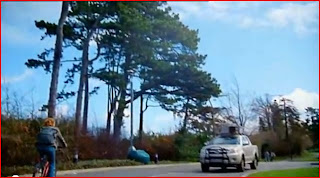
My interpretation of the Tilting Technique is when a scene is shot with the camera moving along its vertical axis, i.e up and down.
I believe this technique was used in this scene to immediately create a contrast between the darkness in the previous scene and the bright warm atmosphere associated with this scene (the audiences attention is drew to the environment), and also the contrast between nature (scenery) and technology (car). The tilt slowly introduces the main cast as they drive and eventually exit their car, the slow paced nature of this effect is an effective measure to introduce these characters as it build up the audiences anticipation. This results in an almost happy atmosphere as the scene is initially shot from a clear blue sky on a seemingly warm, bright day and slowly builds up anticipation amongst the viewers to introduce characters as it patiently crawls vertically down.
Pan

My interpretation of the pan technique is when a subject usually a person or a car is followed by a camera along the horizontal axis, i.e left to right.
I believe this was used in this scene to emphasise this characters dominance and the power behind his words, almost in a military styled fashion as the camera follows him pacing along the room. This results in the audience focusing on him and his words, combined with his dominating presence and stern expression we get the feeling that he has a more powerful position than the other characters and there is more persuasion and power behind his words whether good or bad.
Subscribe to:
Comments (Atom)




























